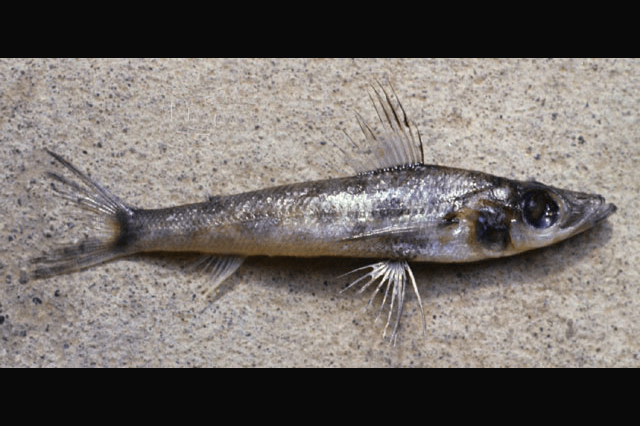Humpback Greeneye, Chlorophthalmus acutifrons Hiyama 1940
Other Names: Black-edge Greeneye, Humpback Cucumberfish

Chlorophthalmus acutifrons. Source: Thomas Gloerfelt-Tarp / FishBase. License: All rights reserved
Summary:
A brown to grey greeneye becoming pale below with silvery sides, several dark brown oblong mid-lateral patches along the side, a black anus surrounded by dark grey, a broad dark grey margin and narrow dark grey basal band on the dorsal fin, a dark grey caudal fin, and the pelvic fins with inner dark grey margins.
As the common name suggests, adults of this species have a distinct hump-like dorsal profile.
As the common name suggests, adults of this species have a distinct hump-like dorsal profile.
Cite this page as:
Bray, D.J. 2020, Chlorophthalmus acutifrons in Fishes of Australia, accessed 10 Jul 2025, https://fishesofaustralia.net.au/Home/species/5262
Humpback Greeneye, Chlorophthalmus acutifrons Hiyama 1940
More Info
|
Distribution |
North of Cape Leveque to west of Cartier Island, Western Australia, and the northern Coral Sea, Queensland, to off Cape Hawke, New South Wales. Elsewhere the species occurs in the tropical, east-Indo-west Pacific: India and Myanmar, east to Japan, Australia, and northern New Zealand. |
|
Features |
Dorsal fin 11-12; Anal fin 9-10; Pectoral fin 15-16; Lateral-line sales 50-53; Gill rakers 18-19; Vertebrae 45-46. Body depth >22% SL; Head moderate, ~30-32% SL; snout moderate; eye moderate, diameter ~ 28-34% HL. Tip of lower jaw jutting slightly forward of upper jaw, exposed upper surface mostly with a smooth toothless anterior margin, and a double row of small depressible teeth posteriorly, preceded in some individuals by 1-2 rows or patches of smaller teeth on the lateral surface of the jaw. Pectoral fins of moderate length, ~30% SL. |
|
Biology |
Greeneyes are synchronous hermaphrodites, and are bioluminescent, with a ventral light organ. |
|
Etymology |
The specific name acutifrons is from the Latin acutus (= sharp, pointed) and frons (brow, forehead), possibly in reference to the sharply pointed head of this species. |
|
Species Citation |
Chlorophthalmus acutifrons Hiyama 1940, Japanese Journal of Zoology 9: 171, figs 2, 3A. Type locality: Kumano-Nada, Japan, depth 500 m. |
|
Author |
Bray, D.J. 2020 |
|
Resources |
Humpback Greeneye, Chlorophthalmus acutifrons Hiyama 1940
References
Bineesh, K.K., Akhilesh, K.V., Gomon, M.F., Abdussamad, E.M., Pillai, N.G.K. & Gopalakrishnan, A. 2014. Redescription of Chlorophthalmus corniger, a senior synonym of Chlorophthalmus bicornis (Family: Chlorophthalmidae). Journal of Fish Biology 84(2): 513-522.
Carpenter, K.E., Robertson, R., Matson, C. & Rivera Higueras, M. 2019. Chlorophthalmus acutifrons. The IUCN Red List of Threatened Species 2019: e.T123321944A123322292. https://dx.doi.org/10.2305/IUCN.UK.2019-3.RLTS.T123321944A123322292.en. Downloaded on 19 October 2020.
Fricke, R. & Durville, P. 2020. Chlorophthalmus vulcanus, a new species of greeneye from La Réunion, southwestern Indian Ocean (Teleostei: Chlorophthalmidae). FishTaxa 17: 1-11. See ref online
Gomon, M.F. 2015. Families Chlorophthalmidae, Bathysauropsidae. pp. 547-552 in Roberts, C.D., Stewart, A.L. & Struthers, C.D. The Fishes of New Zealand. Wellington : Te Papa Press Vol. 2 pp. 1-576.
Gomon, M. F., Ward, R.D., Chapple, S. & Hale, J.M. 2014. The use of DNA barcode evidence for inferring species of Chlorophthalmus (Aulopiformes, Chlorophthalmidae) in the Indo-West Pacific. Marine and Freshwater Research 65: 1027–1034 https://doi.org/10.1071/MF13245
Iwamoto, T. & McCosker, J.E. 2014. Deep-water fishes of the 2011 Hearst Philippine biodiversity expedition of the California Academy of Sciences. pp. 263-332 in Williams, G.C. & Gosliner, T.M. (eds) The Coral Triangle: the 2011 Hearst Philippine biodiversity expedition. California: San Francisco, California Academy of Sciences, 593 pp. See ref at BHL
Last, P.R., Pogonoski, J.J., Gledhill, D.C. White, W.T. & Walker, C.J. 2014. The deepwater demersal ichthyofauna of the western Coral Sea. Zootaxa 3887(2): 191–224
Paxton, J.R. & Niem, V.H. 1999. Families Aulopidae, Chlorophthalmidae, Ipnopidae, Scopelarchidae, Notosudidae. pp. 1919-1927 in Carpenter, K.E. & Niem, V.H. (eds). The Living Marine Resources of the Western Central Pacific. FAO Species Identification Guide for Fisheries Purposes. Rome : FAO Vol. 3 pp. 1397-2068.


